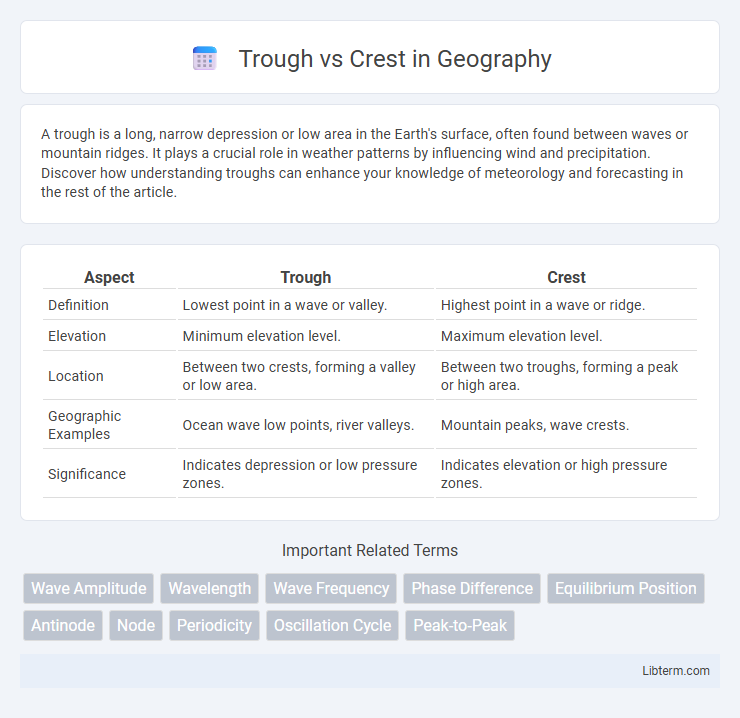A trough is a long, narrow depression or low area in the Earth's surface, often found between waves or mountain ridges. It plays a crucial role in weather patterns by influencing wind and precipitation. Discover how understanding troughs can enhance your knowledge of meteorology and forecasting in the rest of the article.
Table of Comparison
| Aspect | Trough | Crest |
|---|---|---|
| Definition | Lowest point in a wave or valley. | Highest point in a wave or ridge. |
| Elevation | Minimum elevation level. | Maximum elevation level. |
| Location | Between two crests, forming a valley or low area. | Between two troughs, forming a peak or high area. |
| Geographic Examples | Ocean wave low points, river valleys. | Mountain peaks, wave crests. |
| Significance | Indicates depression or low pressure zones. | Indicates elevation or high pressure zones. |
Introduction to Trough and Crest
A trough represents the lowest point in a wave cycle, marking the transition between the descending and ascending phases of a wave. The crest is the highest point in a wave cycle, indicating the peak of wave energy before it begins to descend. Understanding troughs and crests is essential for analyzing wave patterns in fields such as oceanography, acoustics, and signal processing.
Understanding Wave Anatomy
A wave's anatomy consists of troughs and crests, where the crest represents the highest point and the trough the lowest point of the wave cycle. Measuring the vertical distance between the crest and trough determines the wave height, a key factor in oceanography and physics. Understanding these components is essential for analyzing wave behavior, energy transfer, and their effects on coastal environments.
Definition of Trough in Waves
The trough in waves is the lowest point between two crests, representing the minimum value of the wave's displacement. It is a critical feature in wave analysis, indicating the downward displacement from the equilibrium position in transverse waves. Understanding the trough helps in calculating wave amplitude and wavelength, essential parameters in physics and engineering.
Understanding the Crest in Waveforms
The crest in waveforms represents the highest point of a wave cycle, indicating maximum positive displacement from the equilibrium position. Understanding the crest is essential for analyzing wave amplitude, which measures the wave's energy and intensity across various applications like sound, light, and water waves. Accurate identification of the crest allows for precise calculations of wave properties such as frequency, wavelength, and signal strength in both analog and digital systems.
Trough vs Crest: Key Differences
Trough vs crest represents the key difference in wave patterns, where the trough is the lowest point and the crest is the highest point of a wave cycle. The trough marks the point of minimum displacement below the equilibrium, while the crest indicates maximum displacement above the equilibrium position. Understanding the distinction between trough and crest is essential in fields like oceanography, acoustics, and physics for analyzing wave behavior and energy transmission.
Importance in Physics and Engineering
The concepts of trough and crest are fundamental in wave physics, representing the lowest and highest points of a wave, respectively, and are critical for analyzing wave amplitude, frequency, and energy transfer. In engineering, understanding troughs and crests is essential for designing structures to withstand stresses caused by oscillations, vibrations, and load fluctuations, especially in fields like civil, mechanical, and ocean engineering. Accurate measurement of troughs and crests enables optimization of signal processing, acoustics, and electromagnetic applications, enhancing performance and durability in practical systems.
Real-life Examples of Troughs and Crests
Troughs and crests represent the lowest and highest points of a wave, respectively, and are observable in ocean waves where crests form wave peaks and troughs mark the wave valleys. In sound waves, crests correspond to compressions and troughs to rarefactions, influencing how sound propagates through air. These phenomena are critical in understanding seismic activity, where crests and troughs in seismic waves indicate stress variations in the Earth's crust during earthquakes.
Applications in Various Fields
Troughs and crests in waveforms are critical in fields such as oceanography and signal processing, where crests represent maximum amplitudes and troughs indicate minimum points. In engineering, analyzing troughs and crests helps in stress testing materials subjected to cyclic loads and vibration analysis. Meteorology uses the concept to predict weather patterns, interpreting troughs as regions of low pressure and crests as high-pressure zones influencing storm development and airflow.
Common Misconceptions About Trough and Crest
Troughs and crests in wave terminology are often confused, with many mistakenly believing that troughs represent the highest points and crests the lowest. In reality, a crest is the highest point of a wave, while the trough is its lowest point, representing the wave's maximum downward displacement. Misunderstanding these terms can lead to errors in fields like oceanography, acoustics, and signal processing where accurate wave analysis is crucial.
Conclusion: Trough and Crest in Everyday Life
Troughs and crests play vital roles in everyday life by representing the lowest and highest points in wave patterns, such as sound waves, ocean waves, and light waves. Understanding these concepts helps in fields like meteorology, engineering, and communication technology, enhancing the design of instruments and systems that rely on wave behavior. Recognizing the interplay between troughs and crests allows for improved prediction, analysis, and application of wave phenomena in daily activities and scientific advancements.
Trough Infographic

 libterm.com
libterm.com